In The Girl With The Sealskin Dress Mairi moves from Largs to Stromsay, a small island in the Pentland Firth. Stromsay is by no means my own creation; as I mention in the Author’s Note, Mairi’s new home is in fact a thinly veiled reimagining of Stroma, itself a small island a couple of miles northwest of John o’ Groats in the real-life Pentland Firth.
Stroma is a fascinating place. I think I first read about the island in Bella Bathurst’s The Wreckers, which told the history of wreck salvage and smuggling around the Pentland Firth (amongst other places). The islanders were mostly crofters and fishermen, and in the mid-twentieth century a once thriving community dwindled away to almost nothing. The island’s last permanent inhabitants left in 1962, although lighthouse keepers and their families apparently still lived on the island until the nineties. Alas, in 1997 the lighthouse was automated and goodness knows how many continuous centuries of habitation on Stroma came to an end. Bella Bathurst tells the story of how James Simpson, a former Stroma resident, came to purchase the island after it was abandoned, and he has now transferred ownership of the island to his son William, who uses the island for grazing and farming.
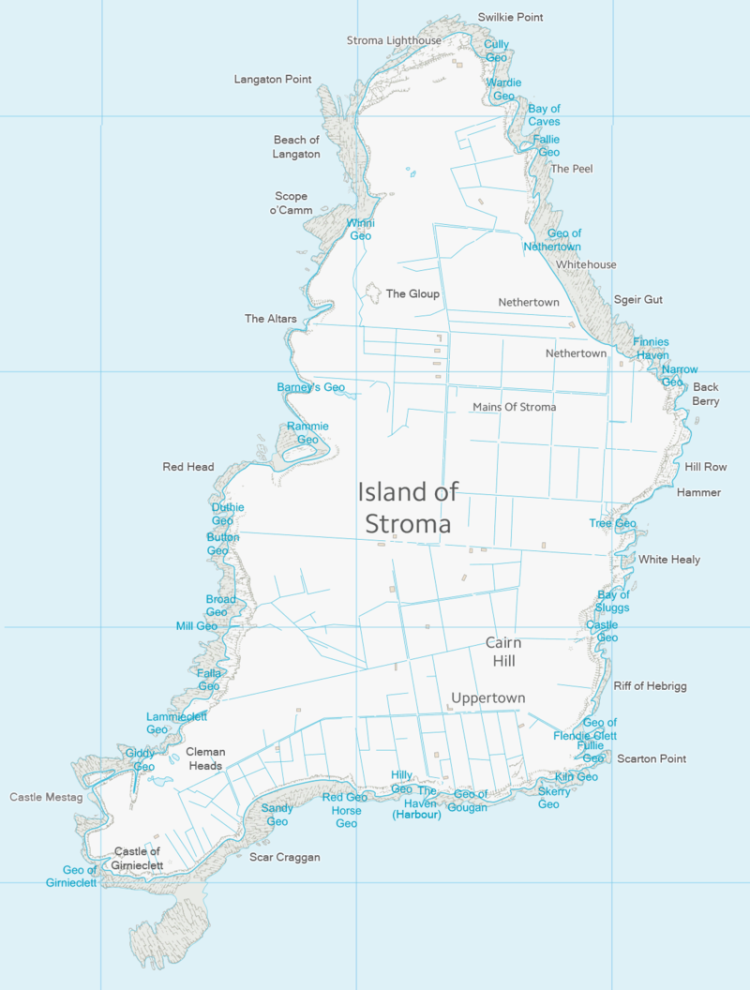
Map of Stroma, courtesy of the Ordnance Survey
I don’t recall precisely when I decided to take Stroma’s intriguing past and turn it into a full-blown tale of wrecking in Northern Scotland, nor when I realised it would combine well with a story based on selkie myths I’d been brewing for a while. Anyway, I started writing the story in early 2013, abandoned it to work on other projects, then resumed writing towards the end of 2014. By summer 2015 I had almost finished the first draft, and although I was pleased with the setting, something was missing: I hadn’t actually seen Stroma, let alone set foot on its shores. Sure, I’d read everything I could about the island in the Edinburgh and Scottish Collection section of Edinburgh’s Central Library, and scoured the internet for as much information as I could find, but text and photographs are no substitute for the real thing.
I had to go there, and soon.
Luckily, my wife and I had already been talking about going north somewhere for a wee break. It didn’t take too much persuading before we’d settled on Thurso as our destination — neither of us had travelled that far north in Scotland before — and so the plan was set. After some internet digging, I found out that Catherine Byrne, former resident of Stroma (and last child to be born on the island!) and author of the wonderful Follow The Dove, was willing to put people in touch with Stroma’s owner. I emailed her, and barely ten minutes later she replied with William Simpson’s phone number and a message saying she’d love to read my book once it’s done — Catherine, the book is on its way!
So, after a night’s stop-over in Inverness we headed north and reached Wick by early afternoon. This was a deliberate detour to visit Old Pulteney, distillers of a wonderfully fresh, sea-salty single malt whisky that wins too many awards to count. Since my wife hates whisky, I got her complimentary drams as well, and after purchasing my compulsory souvenir glass we were on the way to Thurso (I wasn’t driving, obviously…) Oh, we also saw the shortest street in the world:
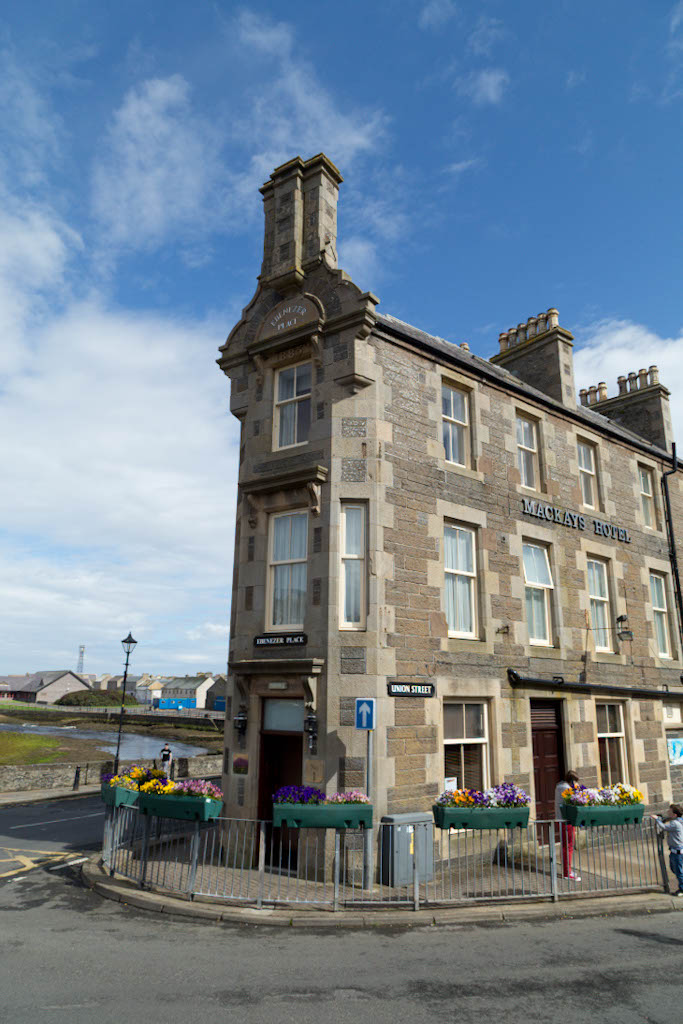
Ebenezer Place, Wick – the world’s shortest street
We’d booked three nights at Camfield House, an impossibly luxurious Thurso bed & breakfast with a mini-golf course, full-sized snooker table, complimentary evening drinks, gorgeous food and more general wonderfulness than you can shake a stick at. Seriously, folks: stay here if you ever get the chance, it’s amazing. Alas, despite (or possibly because of) it being the end of June, the weather report for our stay wasn’t promising; not always raining, but worryingly windy. One of the myriad reasons Stroma’s population fell was due to a lack of decent shelter for boats, and the islanders were used to being cut off for weeks at a time in bad winters. This meant that our hopeful trip to Stroma was in jeopardy, and sure enough, when I phoned William Simpson he was happy to take us over, but wasn’t sure when or if it would be possible in the two full days we had in Caithness.
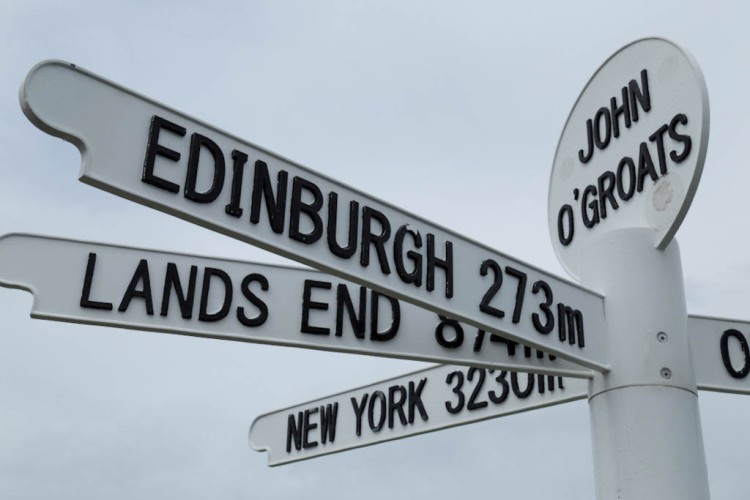
A long way from home…
Our first full day was too windy for a trip across the Pentland Firth, so we visited The Castle of Mey (former residence of the Queen Mother) and John o’ Groats before getting utterly drenched en route to Duncansby Head. We reached the lighthouse shivering and soaked through, and then the weather decided to turn really mean. Further progress was impossible, so we abandoned our walk to Duncansby Stacks and returned to Thurso; we’d seen Stroma from afar, if nothing else. Fortified by baths, snooker, beer, wine and a lovely meal, we readied ourselves for a potential trip to the island the next day.
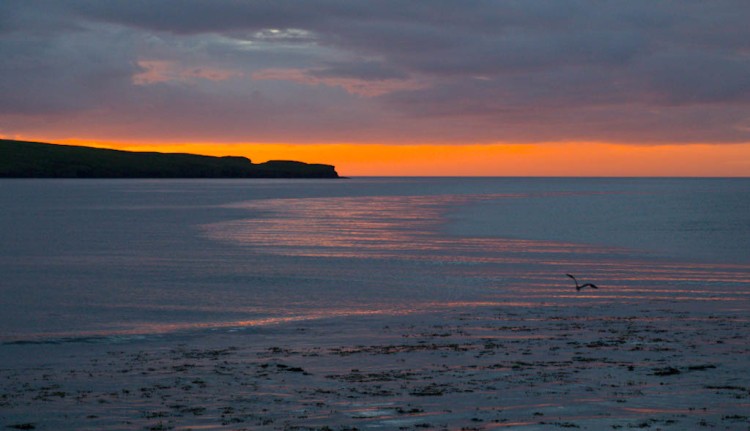
Thurso Bay and the Simmer Dim
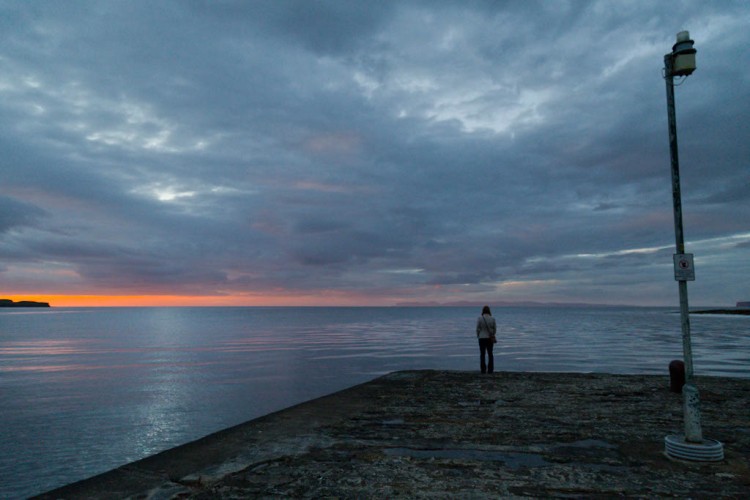
Caz at Thurso Harbour
Next morning I phoned William Simpson again, and hurrah! the forecast was rain but less wind, and he was planning to do some work on Stroma that afternoon. We met him and his friend at a harbour in Gills around 10 a.m., and were soon carving our way across the unusually calm Pentland Firth, Stroma growing closer with every passing second. He dropped us off at The Haven, Stroma’s main harbour on the southern coast. It was built in the nineteen-fifties (I think) in an attempt to improve access to the island and halt the already precipitous population decline; one book I’ve read suggested this merely made it easier for families to leave.
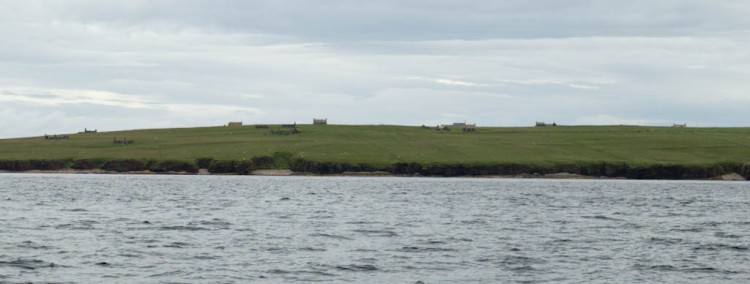
Approaching Stroma
Anyway, William and his friend puttered off in his boat to work somewhere else on the island, leaving my wife and I with four precious hours to explore Stroma as we pleased. I’d already asked if anywhere was off-limits; William replied with a pleasing shrug and a simple you’ll know what’s sensible. So we followed the harbour road inland then cut across the grasslands to the former village of Uppertown, then followed the overgrown road north past the church and into Nethertown.
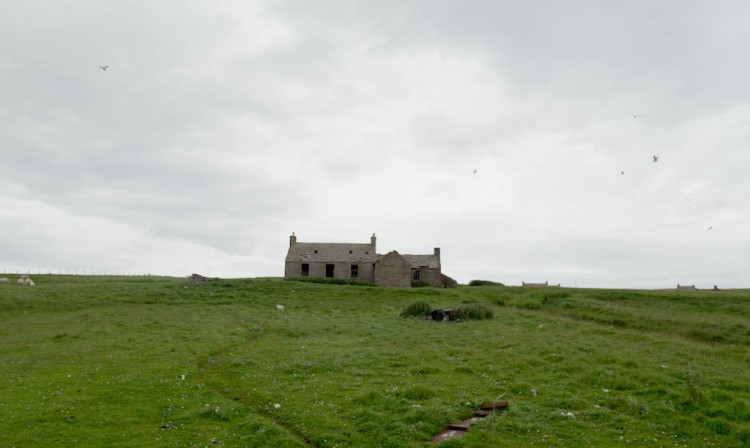
The first croft we encountered
The crofts of Stroma lie pretty much as they were when abandoned all those years ago. Bedframes rust in draughty rooms; chairs and mangles now occupy box-beds built into the wall; doors lie skew-whiff against walls, long since fallen or removed from their hinges. Sheep roam the island freely, and obviously take shelter in the ruins during bad weather. Most of the crofts — already low-ceilinged by modern standards — were so full of impacted mud and sheep shit the floor was two feet higher than normal; we had to walk bent double between rooms and some of the fireplaces were barely visible behind the muck. Some crofts had tiny ladder-like flights of stairs leading to dusty, pigeony lofts littered with leftover timber, luggage and all manner of intriguing detritus. We couldn’t see much evidence of the island’s farming past — everything had turned grassy and choked with weeds — but we barely moved a few steps without encountering yet more sheep, presumably shocked and put out by the presence of actual human beings invading their home.
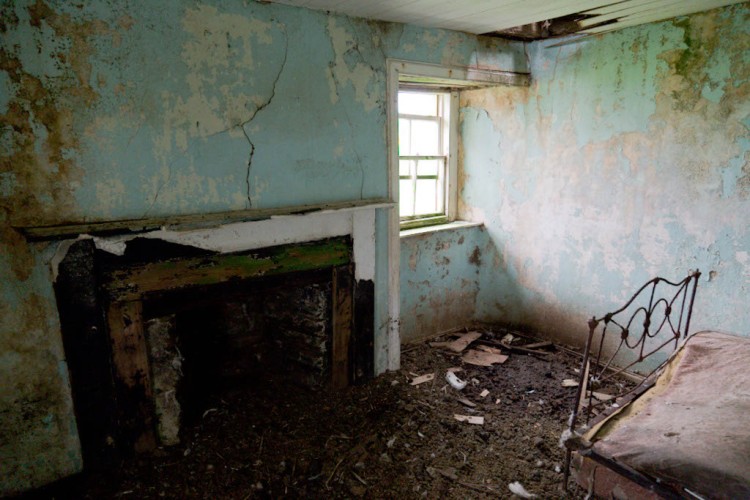
Inside a croft
After passing the island’s church, schoolhouse and war memorial, then Stroma Mains on our right (the island’s only large farm, and a source of contention and resentment according to James Simpson, as quoted by Bella Bathurst) we cut across the marshy western half of the island to visit the Gloup. Simply put, The Gloup is a gigantic hole in the ground with the sea at the bottom, the legacy of a roof collapse in a sea tunnel that bored a considerable way inland. It’s terrifyingly deep and steep-sided, and although it was low tide when we visited, waves still lapped at the rocks far beneath us. Ominously, a long-dead sheep, gassy and inflated through decay, bobbed gently in the waters below. The tunnel to the sea looked wonderfully grand and begged to be explored.
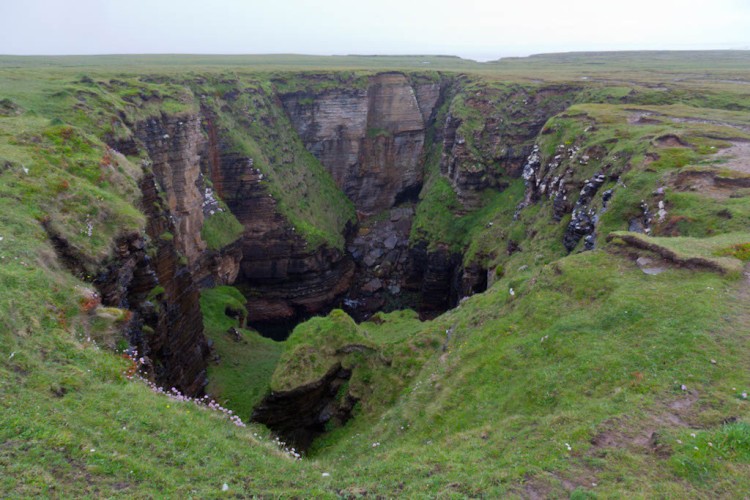
The Gloup

The tunnel to the sea and a deid sheep
We carried on north, and by the time we’d passed through Nethertown the rain had returned with a vengeance, so we took shelter in the foghorn building near Stroma Lighthouse on the island’s north coast. When the rain passed by we had a wonderful view of the Sheep Skerries at low tide (inspiration for the Sgeirskerry so crucial to Mairi’s story in Sealskin) and a colossal pod of seals on the skerries of Langaton Point. We were walking along the cliffs overlooking the skerries, at least twenty-five metres above and two hundred metres away from the seals, but one of them spotted us and over the next minute or so the entire pod (somewhere between one and two hundred seals, my photos suggest!) lumbered into the sea and swam off.
Some of them swam south and west (as though keeping an eye on us!) as we walked along the impressive cliffs overlooking Scope o’ Camm and the sheer-sided geo forming the entrance to the Gloup. Alas, by then we’d already run out of exploring time, so we cut straight across the marshy landscape south of the Gloup, making for the church on the skyline. This involved some convoluted navigation around bogs and temporary lakes, and the local seabirds were seriously hacked off at our presence. Much dive-boming ensued, but since it was past nesting time, no actual beak-and-claw assaults occurred. We met William and his friend back at The Haven at 3 p.m., and left Stroma with heavy hearts and and an itching desire to return.
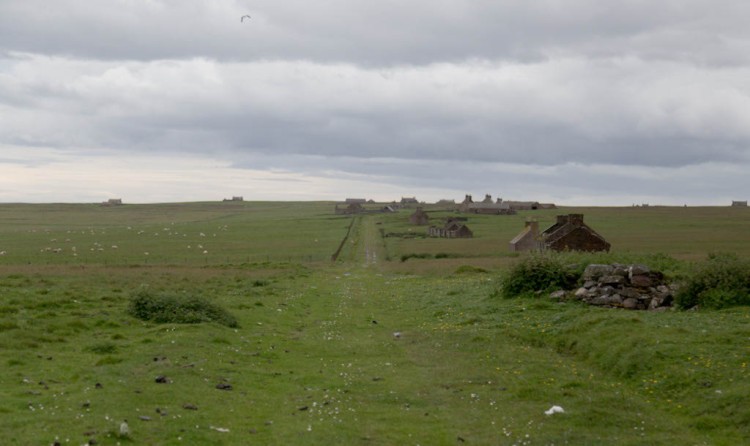
Looking south to Nethertown
So, after all that, what was Stroma actually like? Despite everything, it wasn’t a sad place; I didn’t feel loss or sorrow whilst exploring the former homes of people long gone and now most likely passed on. Perhaps it was because the inhabitants chose to leave the island, rather than being evicted through coercion or force; perhaps it was because the sheep and the birds and the seals gave the island life and vitality, making it a real place rather than a mere location on a map. Maybe it was the surprisingly good condition of the crofts we explored — open to the elements they might’ve been, but they were clearly built to last, and most would’ve provided decent, warm, dry shelter for any desperate soul passing by — or the traces of occupation left behind, making the island’s past tangible and real rather than an abstract history to be pondered. Yes, it was an impossibly bleak and windy place — Mairi’s initial imaginings aren’t far from the truth — but also quiet, fertile, beguiling and beautiful. It was so easy to picture people living, thriving and dying there, and as far as my little story was concerned, I could see every part of Mairi’s tale playing out across the landscape I’d previously constructed from textual accounts, photographs and my imagination.
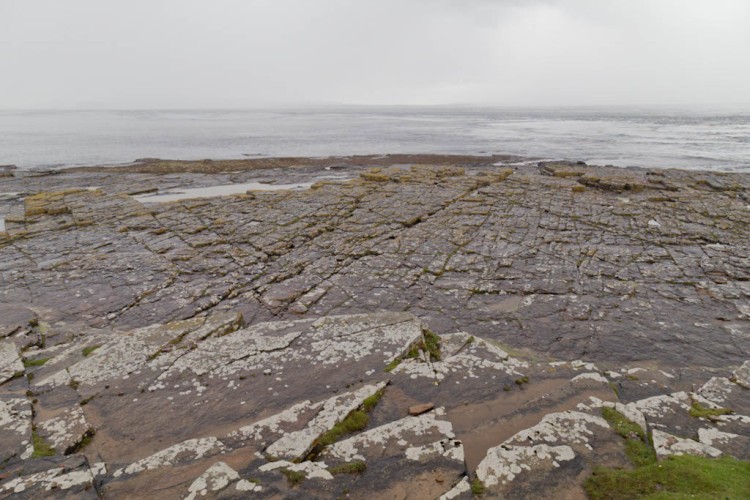
The Sheep Skerries, inspiration for the Sgeirskerry
Lastly, how does my Stromsay compare to Stroma, its real-life twin? The geography of Stromsay follows that of Stroma closely, although certain features are very much exaggerated to suit the plot – the semicircle of cliffs surrounding the Sgeirskerry, for example, does not exist in real life. My fictional Gloup is much bigger and more sheer-sided than Stroma’s; I made the tunnel to the sea unnavigable by boat and mostly underwater, whilst kayakers and the like can easily access the real Gloup in fair weather. I’ve no idea whether Stroma is riddled with caves and tunnels; probably not, because reality is rarely as exciting as fiction, and there is no equivalent of Castle Cammo on the island; Castle Mestag is marked as occupying an isolated stack in the southwest of the island, but virtually nothing remains.
Overall, I hope I’ve done Stroma justice in Sealskin. I loved writing about my reimagined version of the island, and my visit two summers ago was a rare privilege I’ll cherish forever. Many thanks to Catherine Byrne and William Simpson for making it possible.
Here’s a small gallery of pictures I took while I was there (click on the photos to enlarge):
More useful information about Stroma can be found here:


























Hi my grandad and my gran and my dad and brother and sister lived on Stroma then they went to live at Huna the family name is Dundas I would love to visit it one day Elaine Dundas I enjoyed the story
LikeLike
Hi Elaine, I’m glad you enjoyed the blog. Stroma is definitely a wonderful place to visit! I see there’s a Mathew Dundas listed as the resident of croft 61 on this map of Stroma’s last residents:
http://www.caithness.org/atoz/stromamain/stromalargemap.htm
Was Mathew your grandfather?
LikeLike
Hi my dad and his dad my grandad were both called Matthew Dundas
LikeLike
Yes that was there place NO 61 I would love to on Stroma and find the place hope to one day
LikeLike
Hi
I enjoyed your blog.
My grandmother Elizabeth nee Simpson and grandfather George Robertson came from Stroma. My husband and I enjoyed a trip to Stroma for the first time 2 years ago. Hope to go back again and do some more exploring. It was fantastic to find the houses my grandparents grew up in the late 1800’s early 1900’s
Margie Brown
LikeLike
Hi Margie, thanks for getting in touch, and I’m glad you enjoyed the blog. It must have been a wonderful experience to visit the houses your grandparents lived in – I hope you manage a return visit soon! 🙂
LikeLike
Hi, I was very interested in your visit to Stroma as I am planning a very cathartic trip there in May this year.
I lost my dear husband, of over 60 years last July and in order to help me cope I am arranging to go to Stroma as he was stationed there at the Lighthouse in 1965 when training to become a lighthousekeeper and he wrote to me extensively from there describing the place and wishing that I could see it for myself. Over the years we never made it there and I really want to do this trip in his memory. The telephone box which you photographed was very poignant to me as I used to phone him there on a Sunday with varying degrees of success as the line was not good. I have made arrangements with Willie Simpson to take me, along with my son and cousin to hopefully go on 19th May. We just pray the weather will be kind to us. As I am over 80 years and not very fit, I have gone into gentle training, walking and trying to build up my strength. Willie Simpson was a small boy of about 5 when my husband was on the Island and the family actually lived on the Island then but had to leave when Willie had to go to school. I would be pleased for any pointers you can give me about making the most of our visit.
Thank you.
Careen MacKenzie
LikeLike
Where can I buy an actual copy of the book? I’d like to give them to my granddaughters.
Cath
LikeLike
Hi Cath! Thank you so much for your interest, but unfortunately Sealskin isn’t available in a physical edition at the moment. At present it’s digital-only, but I’ve made it temporarily unavailable for purchase whilst a Highlands-based publisher considers the MS for their new YA imprint. If that doesn’t work out I’m planning on making the book available in physical as well as digital formats, so I shall keep you informed!
LikeLike
Hi Miller
I enjoyed your blog and wonder whether you have managed to publish your book yet.
I was excited to see that an Elaine Dundas had written to you as I am certain that I must be related to her and would love it if she chose to make contact with me. My grandfather (who I never knew) was born on Stroma in 1894 to Matthew Dundas and his wife Elizabeth Dundas(nee More)and was called Alexander More Dundas. I believe that Matthew jnr may have been his elder brother(by two years) and Ellen his elder sister by five years. Alexander became a merchant seaman and was in the RNR in the First World War and married my grandmother in Cork in 1917. At some point thereafter they moved to Inverurie where my father was born in December 1919. Subsequently Alexander joined the Nigerian Marine Service and neither my father nor my grandmother ever really spoke about him except to say that he was lost at sea when my father was a small boy.My grandmother always kept a framed photograph of him in her dining room and she never remarried.
If you could kindly pass on this email to Elaine I would be most grateful.
Yours Sincerely
Robert Dundas.
LikeLike
Hello Robert,
Thank you for your message – it’s wonderful to hear from people with Stroma connections. I’ve emailed you separately and passed on your message to Elaine as well; I wish you all the best and I have my fingers crossed it leads to a family reconnection 🙂
best regards,
Miller
LikeLike
Miller – thank you for writing this very interesting blog and publishing it online. However I was somewhat bemused by Robert’s remarks as Alexander More Dundas from Stroma is my grandfather and he died in 1973. My mother (Alexander More Dundas’s daughter) often talks about her trips to Stroma and has a photograph of Elizabeth Dundas (Lizzie More) who would have been my great grandmother.
Robert
I’m not sure if you will see this as more than a year has passed since you left this comment. I was very surprised to read the above as the Alexander More Dundas you describe is my grandfather and he died in 1973.
Some research has revealed the following:
When Alexander Dundas was born in 1880 in Forfar , Angus, his father, David, was 40 and his mother, Elizabeth, was 35. He married Victoria Violet Sillett in 1917 in Cork, Cork. She was born on 27 Nov 1897 or 1898 in Cork to Helen & Alfred.
They had two children during their marriage. Their daughter Violet Helena May was born on 14 August 1918 in Cork and died on 24 March 2001 in Portsmouth. Their son Alexander Derek Stewart was born on 7 December 1919 in Inverurie.
Alexander senior died in 1932 in Lagos, Nigeria, at the age of 52.
Victoria died on 22 December 1975 in Portsmouth, Hampshire, at the age of 77.
Is it possible that there has been a mix up of Alexander Dundases – there are many people with that name – and do any of the details above relate to your family?
Kind regards
Linda Gordon
LikeLike
Hi I am Elaine Dundas I had been in contact with Robert and we are related but due to personal circumstances I had not replied to Robert but will give him a ring soon I will look out my family tree info due to the virus might not be able to get things photo copied but will try regards Elaine
LikeLike
Hi Robert sorry not being in touch long story but personal problems and had to move getting there now but then lockdown I can across some family tree stuff I have when I get s chance I will photocopy and send I will give you a ring this week Regards Elaine Dundas
LikeLike